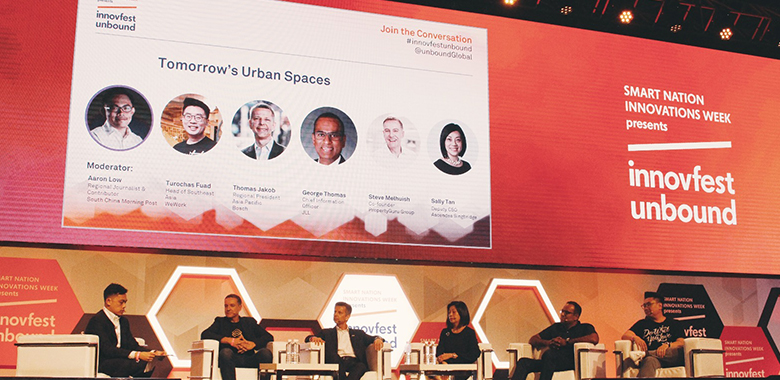Focus on people when building smart cities

TL:DR: By the year 2050, more than 68 percent of the world’s population will live in cities. Governments around the world are thus focussing on making their cities smart and sustainable. An expert panel at the InnovFest Unbound 2018 conference shared their views on the present state and possible evolution of urban spaces and smart cities.
Like moths to fire, people are gravitating towards urban centres all over the world. The United Nations estimates that 55 percent of the global population now resides in urban areas, and this percentage is expected to increase to 68 percent by 2050.
Anticipating this massive shift in population distribution, governments around the world are exploring ideas to make cities smarter and more liveable. While technology plays a big role in creating the smart urban spaces of tomorrow, it is not the only ingredient, said an expert panel at the InnovFest Unbound 2018 conference held at the Marina Bay Sands Convention Centre in Singapore.
The panel comprised Ms Sally Tan, deputy chief customer solutions officer, Ascendas-Singbridge; Mr George Thomas, chief information officer APAC and head of technology, data and information management, JLL; Mr Steve Melhuish, co-founder and vice chairman of PropertyGuru; Mr Thomas Jakob, regional president, Asia Pacific, Bosch Software Innovations; and Mr Turochas “T” Fuad, managing director, WeWork Southeast Asia. Mr Aaron Low, regional journalist and contributor to the South China Morning Post, was the moderator.
Focus on people, not places
“Whenever we talk about smart cities, everyone is fixated about the technologies—which in fact is just the hardware,” said Mr Melhuish. He thinks that the focus of the dialogue should change from the kind of technologies that we can use, to what we can do to help people living in smart cities.
Ms Tan agreed, adding that “whatever exciting latest technologies you may want to apply, you need to make sure that they ultimately make sense to the end users.” She explained how Ascendas-Singbridge’s views on the creation of urban spaces have changed over time.
“In the past, our focus was on building functional spaces,” she said. But in recent years, the real estate solutions provider has come to realise that in addition to being practical, the spaces it builds need to be attractive and inspiring as well.
“They need to come with F&B outlets, fitness centres, childcare centres and so on, so that people would want to commute to this space to work,” she said. This is very much the same approach taken by WeWork, which views the provision of such amenities as “humanising urban spaces”.
“It is about trying to humanise the way we live, work and connect with the rest of the world,” said Mr Fuad. “The core element we look at is people, and then we try to build our spaces around them, to create opportunities and inclusion.”
Finding the right connection
Even as governments and policy planners around the world embark on smart city projects, members of the expert panel were already thinking about the next step, which was to get smart cities to work together. “For instance, the 100 smart cities in India have very different requirements and focuses from those in China, Indonesia and Singapore,” said Mr Jakob.
While no two smart city projects are entirely the same, “we want to look at and develop use cases that make sense across cities, allowing everyone to take advantage of the projects that have already been completed in another country,” he added.
One way to achieve this is via the proposed ASEAN Smart Cities Network (ASCN), which will involve 26 cities in ten ASEAN countries. The initiative, spearheaded by Singapore, aims to bring together cities within and between participating countries to collaborate on technology-driven solutions for congestion, pollution and cybersecurity, among other issues.
The ASCN member countries will also agree upon ASEAN’s definition of a smart city, as well as state guiding principles and core outcomes of smart and sustainable urban development. These will be compiled under the ASEAN Smart Cities Framework, which will be adopted by ASEAN leaders at the 33rd ASEAN Summit in November 2018.
The changing concept of a city
A network of smart cities is an ambitious concept, but Mr Jakob noted that in the future, the very idea of a ‘city’ may be unrecognisable by those alive today.
“If you look at why cities exist in the first place, it was due to a requirement for energy, transport and company infrastructure that had to be centralised. But this is fast becoming less and less practical,” he explained. “What we foresee is that people will eventually move away from large cities to form smaller satellite communities that are somewhat self-contained.”
This will help to minimize the number of cars on the road, as well as the impact on the environment. “The future, therefore, would no longer be about mega-cities anymore, but conglomerations of various satellite communities,” he said.
But to attain such a future, certain foundations have to be built in the present. Mr Thomas thinks a dynamic technology ecosystem, an innovation mindset and an openness to data sharing is crucial if cities want to transform themselves and the lives of their denizens.
“Certain cities are ahead of others at the moment, but everybody will have to get there at some point because these are common aspirations to better the lives of citizens,” he concluded.
https://www.tech.gov.sg/media/technews/focus-on-people-when-building-smart-cities
